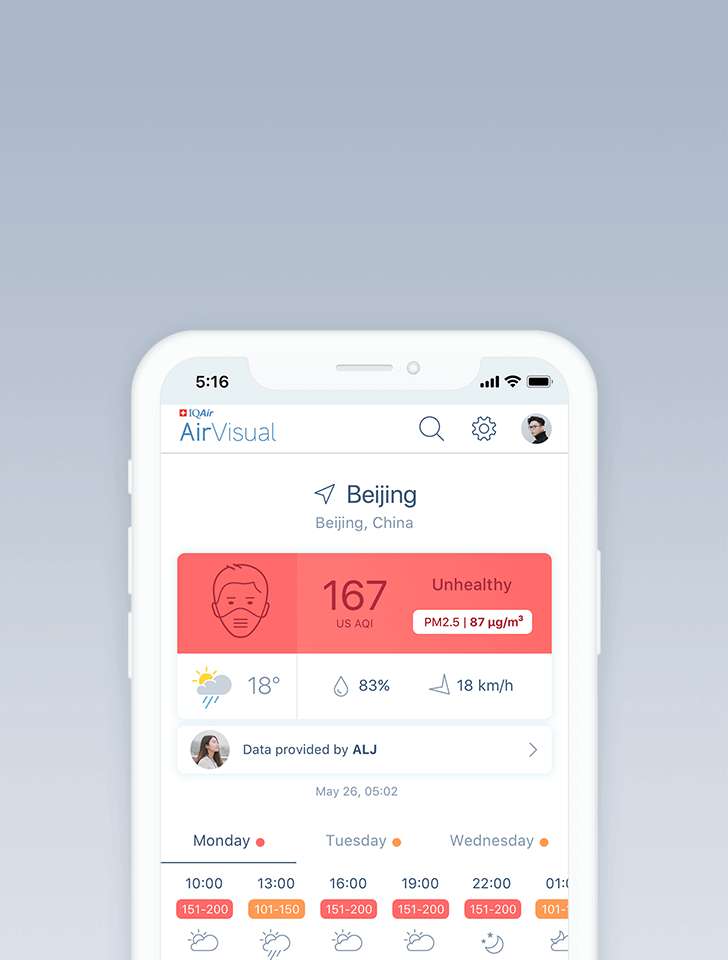Air quality in Linfen
Air quality index (AQI) and PM2.5 air pollution in Linfen
10.2K people follow this city

Linfen Air Quality Map
Real-time Linfen air pollution map
Weather
What is the current weather in Linfen?
| Weather | Clear sky |
| Temperature | 86°F |
| Humidity | 16% |
| Wind | 6.3 mp/h |
| Pressure | 29.6 Hg |
live aqi city ranking
Real-time China city ranking
| # | city | US AQI |
|---|---|---|
| 1 | Xixiang, Henan | 167 |
| 2 | Yangcun, Tianjin | 157 |
| 3 | Wuhan, Hubei | 154 |
| 4 | Hebi, Henan | 153 |
| 5 | Hohhot, Inner Mongolia | 153 |
| 6 | Wuda, Inner Mongolia | 153 |
| 7 | Changping, Beijing | 152 |
| 8 | Yigou, Henan | 152 |
| 9 | Caidian, Hubei | 151 |
| 10 | Huanggang, Hubei | 149 |
(local time)
SEE WORLD AQI RANKING3D animated air pollution map

live Linfen aqi ranking
Real-time Linfen air quality ranking
| # | station | US AQI |
|---|---|---|
| 1 | Tang Yao Hotel | 158 |
| 2 | Municipal party committee | 107 |
| 3 | Water Company | 102 |
| 4 | South of the city | 93 |
| 5 | Lingang Hospital | 82 |
| 6 | Technical school | 82 |
(local time)
SEE WORLD AQI RANKINGUS AQI
93
live AQI index
Moderate
Overview
What is the current air quality in Linfen?
| Air pollution level | Air quality index | Main pollutant |
|---|---|---|
| Moderate | 93 US AQI | PM2.5 |
| Pollutants | Concentration | |
|---|---|---|
| PM2.5 | 32µg/m³ | |
| PM10 | 96µg/m³ | |
| O3 | 162µg/m³ | |
| NO2 | 8µg/m³ | |
| SO2 | 10.5µg/m³ | |
| CO | 600µg/m³ | |
PM2.5
x6.4
PM2.5 concentration in Linfen is currently 6.4 times the WHO annual air quality guideline value
Health Recommendations
What is the current air quality in Linfen?
| Sensitive groups should reduce outdoor exercise | |
| Close your windows to avoid dirty outdoor air GET A MONITOR | |
| Sensitive groups should wear a mask outdoors GET A MASK | |
| Sensitive groups should run an air purifier GET AN AIR PURIFIER |
Forecast
Linfen air quality index (AQI) forecast
| Day | Pollution level | Weather | Temperature | Wind |
|---|---|---|---|---|
| Monday, Apr 22 | Unhealthy for sensitive groups 135 AQI US | 80.6° 62.6° | ||
| Tuesday, Apr 23 | Moderate 59 AQI US | 73.4° 57.2° | ||
| Wednesday, Apr 24 | Moderate 99 AQI US | 82.4° 55.4° | ||
| Today | Moderate 93 AQI US | 86° 62.6° | ||
| Friday, Apr 26 | Moderate 77 AQI US | 89.6° 66.2° | ||
| Saturday, Apr 27 | Moderate 93 AQI US | 84.2° 68° | ||
| Sunday, Apr 28 | Unhealthy for sensitive groups 103 AQI US | 82.4° 66.2° | ||
| Monday, Apr 29 | Unhealthy for sensitive groups 110 AQI US | 66.2° 55.4° | ||
| Tuesday, Apr 30 | Moderate 71 AQI US | 71.6° 51.8° | ||
| Wednesday, May 1 | Moderate 59 AQI US | 75.2° 55.4° |
Interested in hourly forecast? Get the app
AIR QUALITY ANALYSIS AND STATISTICS FOR Linfen
What is the level of air pollution in Linfen?
Linfen is a prefecture-level city in the southwest of Shanxi province, China. It runs along the banks of the Fen River and has an area of over 20,000 square kilometres. A census conducted in 2010 estimated the population to be around 4.3 million people and placed almost 1 million in the metropolitan area of Yaodu.
Prior to 1978, Linfen was a very different town. It was famous for its spring water, green surroundings and its strong agricultural background. Since then the coal industry has risen exponentially and ruined this original image. No longer can it be classed as a green village.
At the start of the second quarter of 2021, Linfen was experiencing a period of “Moderate” air quality with a US AQI reading of 88. This United States Air Quality Index is an internationally recognised system for defining the level of air pollution. The classification system follows guidelines set down by the World Health Organisation (WHO).
There are usually six main pollutants that are measured and used as benchmark figures when comparing like for like. The concentrations of the six pollutants which are measured were as follows: PM2.5 - 30 µg/m³, PM10 - 22 µg/m³, ozone (O3) - 139 µg/m³, nitrogen dioxide (NO2) - 10 µg/m³, sulphur dioxide (SO2) - 4 µg/m³ and carbon monoxide (CO) - 700 µg/m³. The advice for people to follow when pollution levels are this high is to stay indoors as much as possible and to close doors and windows to keep the dirty air outside. Those people who are sensitive to pollution should avoid going outside until the air improves.
The table at the top of this page will help you to decide when it is safe to venture outside again.
Does the level of air pollution in Linfen change throughout the year?
Air pollution is extremely volatile and can change very quickly as it is dependent on many factors. It is very often affected by the weather patterns as they change with the seasons. This can easily be seen by looking at the recently released figures for 2020 on the IQAir website.
Throughout the warmer months of the year from early April until the end of September Linfen was going through a period of “Moderate” quality air with figures between 12.1 and 35.4 µg/m³. For the months of March, October and November, the air quality moved into the next classification level, that of “Unhealthy for sensitive groups” with figures between 35.5 and 55.4 µg/m³. During the colder months of February and December the levels advanced once more into the “Unhealthy” bracket with figures of 68.1 and 63.3 µg/m³ respectively. In January, the level got even worse and plunged into the “Very Unhealthy” category with a reading of 158.4 µg/m³.
Records of air quality were first recorded in 2017 when the air quality figure was 80.6 µg/m³ followed by 68.2 µg/m³ in 2018. Another improvement was noted in 2019 when the recorded figure was 61.7 µg/m³. A much lower figure was recorded in 2020 of 52.5 µg/m³. This figure might be artificially low because of the restrictions in place due to COVID-19 which limited the use of vehicles and closed down some factories on a temporary basis.
Where does the air pollution in Linfen come from?
When China decided its future lay in industrialisation, it openly encouraged the central provinces to become involved. It was at this time that the price of coal increased dramatically due to increased demand. This led to the rapid expansion of privately-owned mines which, as such, were unregulated. Linfen sits on vast coal reserves which were exploited for profit. In 2004, an American organisation, included Linfen in an annual listing of the world’s most badly polluted cities. It was also mentioned on the “Popular Science” website as being particularly polluted. It was around this time that after measurements were taken it was seen that throughout the entire year there were only 15 days when the level of air pollution was acceptable.
What was done to clean the air in Linfen and put an end to air pollution?
After all these negative reports, the local authorities decided on a plan of action. Substandard mines were closed and coal trucks were no longer permitted to enter the city limits which resulted in much less coal dust in the atmosphere. The fuel source for the municipal heating was changed from coal to gas. Because of this, almost 200 large coal-fired boilers were no longer needed and many other smaller ones were also decommissioned.
As of 2007, 85 per cent of the population used natural gas rather than coal for their heating. The State Environmental Protection Agency (SEPA) has forced many of the less-efficient smaller factories to close and enforced stricter standards for larger factories including the installation of sulphur scrubbers to clean their emissions.
Since then, many measures were put in place such as the introduction of emission limits. In 2014, the China Youth Daily reported a noticeable change. They said that Linfen had come from being the “most polluted” city to the “model city of environment protection”.
However, by 2018 it was noted that the city was constantly failing to meet its emissions targets and Linfen was once again on the list for the most polluted cities out of the 168 that were monitored. Further measures are currently underway.
What are the health impacts of Linfen’s polluted environment?
The high levels of pollution are taking their toll on the health of Linfen's inhabitants. Local clinics are seeing a growing number of bronchitis, pneumonia, and lung cancer patients. The children of Shanxi Province also have high rates of lead poisoning. A growing number of local deaths in recent years have been linked to these overwhelming pollution levels.
Arsenicosis is a disease caused by drinking elevated concentrations of arsenic found in water and it is at epidemic levels in the area. Chronic exposure to this toxic chemical results in skin lesions, peripheral vascular disease, hypertension, blackfoot disease, and high cancer incidence rates. A study of Shanxi's well water published in Toxicology and Applied Pharmacology found the rate of unsafe well water in the province to be at an alarming 52 per cent.





